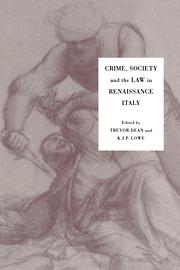Book contents
- Frontmatter
- Contents
- Illustrations
- List of contributors
- Preface
- 1 Writing the history of crime in the Italian Renaissance
- 2 Criminal justice in mid-fifteenth-century Bologna
- 3 The judicial system in Florence in the fourteenth and fifteenth centuries
- 4 The incidence of crime in Sicily in the mid fifteenth century: the evidence from composition records
- 5 Theology, nature and the law: sexual sin and sexual crime in Italy from the fourteenth to the seventeenth century
- 6 Practical problems in the enforcement of Italian sumptuary law, 1200–1500
- 7 The prince, the judges and the law: Cosimo I and sexual violence, 1558
- 8 Intervention by church and state in marriage disputes in sixteenth- and seventeenth-century Florence
- 9 The writer and the man. Real crimes and mitigating circumstances: il caso Cellini
- 10 The political crime of conspiracy in fifteenth- and sixteenth-century Rome
- 11 Fighting or flyting? Verbal duelling in mid-sixteenth-century Italy
- 12 Banditry and lawlessness on the Venetian Terraferma in the later Cinquecento
- 13 Mihi vindictam: aristocratic clans and rural communities in a feud in Friuli in the late fifteenth and early sixteenth centuries
- Index
13 - Mihi vindictam: aristocratic clans and rural communities in a feud in Friuli in the late fifteenth and early sixteenth centuries
Published online by Cambridge University Press: 14 October 2009
- Frontmatter
- Contents
- Illustrations
- List of contributors
- Preface
- 1 Writing the history of crime in the Italian Renaissance
- 2 Criminal justice in mid-fifteenth-century Bologna
- 3 The judicial system in Florence in the fourteenth and fifteenth centuries
- 4 The incidence of crime in Sicily in the mid fifteenth century: the evidence from composition records
- 5 Theology, nature and the law: sexual sin and sexual crime in Italy from the fourteenth to the seventeenth century
- 6 Practical problems in the enforcement of Italian sumptuary law, 1200–1500
- 7 The prince, the judges and the law: Cosimo I and sexual violence, 1558
- 8 Intervention by church and state in marriage disputes in sixteenth- and seventeenth-century Florence
- 9 The writer and the man. Real crimes and mitigating circumstances: il caso Cellini
- 10 The political crime of conspiracy in fifteenth- and sixteenth-century Rome
- 11 Fighting or flyting? Verbal duelling in mid-sixteenth-century Italy
- 12 Banditry and lawlessness on the Venetian Terraferma in the later Cinquecento
- 13 Mihi vindictam: aristocratic clans and rural communities in a feud in Friuli in the late fifteenth and early sixteenth centuries
- Index
Summary
On the last Thursday before Lent (Carnival Thursday) 1511, the celebrations, dances and masquerades planned (despite fierce fighting between imperial and Venetian armies in Friuli) for the last week of Carnival in Udine were interrupted by an unexpected and violent popular revolt. Thousands of peasants, organized in rural militias under the command of Antonio Savorgnan, who had hurried to defend the city from the Austrian troops, on their return from a reconnaissance in the contado, rushed to a district where some noble families and their followers were confronting one another. The brawl soon degenerated, catching by surprise the Venetian rettore, who the evening before had managed to obtain a fragile compromise from the leaders of the rival factions. The peasants together with the common people (popolani) and the inhabitants of the contado, as if observing a prearranged plan, then made a mass assault on the palaces of the feudal and urban nobility, thought to have connived with the enemy.
There followed great commotion and, in the end, a long sequence of brutal lynchings, reconstructed and narrated in strong tones by chroniclers and scholars, concentrating on the grimmest and most hair-raising episodes. The palaces in which the nobles barricaded themselves with their men-at-arms were spread around in various districts within the city walls, crowded together and linked by courtyards and internal passages almost like fortified redoubts, but they were soon broken down by artillery, sacked and set on fire.
- Type
- Chapter
- Information
- Crime, Society and the Law in Renaissance Italy , pp. 249 - 274Publisher: Cambridge University PressPrint publication year: 1994
- 2
- Cited by



